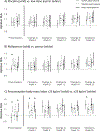Preconception Blood Pressure and Its Change Into Early Pregnancy: Early Risk Factors for Preeclampsia and Gestational Hypertension
- PMID: 32755413
- PMCID: PMC7456510
- DOI: 10.1161/HYPERTENSIONAHA.120.14875
Preconception Blood Pressure and Its Change Into Early Pregnancy: Early Risk Factors for Preeclampsia and Gestational Hypertension
Abstract
Preeclampsia and gestational hypertension are common complications of pregnancy associated with significant maternal and infant morbidity. Despite extensive research evaluating risk factors during pregnancy, most women who develop a hypertensive disorder of pregnancy are not considered high-risk and strategies for prevention remain elusive. We evaluated preconception blood pressure and its change into early pregnancy as novel risk markers for development of a hypertensive disorder of pregnancy. The EAGeR (Effects of Aspirin in Gestation and Reproduction) trial (2007-2011) randomized 1228 healthy women with a history of pregnancy loss to preconception-initiated low-dose aspirin versus placebo and followed participants for up to 6 menstrual cycles attempting pregnancy and throughout pregnancy if they became pregnant. Blood pressure was measured during preconception and throughout early gestation. The primary outcomes, preterm preeclampsia, term preeclampsia, and gestational hypertension, were abstracted from medical records. Among 586 women with a pregnancy >20 weeks' gestation, preconception blood pressure levels were higher for preterm preeclampsia (87.3±6.7 mm Hg mean arterial pressure), term preeclampsia (88.3±9.8 mm Hg), and gestational hypertension (87.9±9.1 mm Hg) as compared with no hypertensive disorder of pregnancy (83.9±8.6 mm Hg). Change in blood pressure from preconception into very early pregnancy was associated with development of preeclampsia (relative risk, 1.13 [95% CI, 1.02-1.25] per 2 mm Hg increase in mean arterial pressure at 4 weeks' gestation), particularly preterm preeclampsia (relative risk, 1.21 [95% CI, 1.01-1.45]). Randomization to aspirin did not alter blood pressure trajectory or risk of hypertension in pregnancy. Preconception blood pressure and longitudinal changes during early pregnancy are underexplored but crucial windows in the detection and prevention of hypertensive disorders of pregnancy. Registration- URL: http://www.clinicaltrials.gov. Unique identifier: NCT00467363.
Keywords: blood pressure; hypertension; preeclampsia; pregnancy; risk factors.
Figures


References
-
- Hutcheon JA, Lisonkova S, Joseph KS. Epidemiology of pre-eclampsia and the other hypertensive disorders of pregnancy. Best practice & research. Clinical obstetrics & gynaecology. 2011;25:391–403 - PubMed
-
- American College of Obstetricians and Gynecologists. Hypertension in pregnancy. Report of the american college of obstetricians and gynecologists’ task force on hypertension in pregnancy. Obstetrics and gynecology. 2013;122:1122–1131 - PubMed
-
- Hirshberg A, Srinivas SK. Epidemiology of maternal morbidity and mortality. Seminars in perinatology. 2017;41:332–337 - PubMed
-
- American College of Obstetricians and Gynecologists. Acog committee opinion no. 743: Low-dose aspirin use during pregnancy. Obstetrics and gynecology. 2018;132:e44–e52 - PubMed
Publication types
MeSH terms
Substances
Associated data
Grants and funding
LinkOut - more resources
Full Text Sources
Medical

